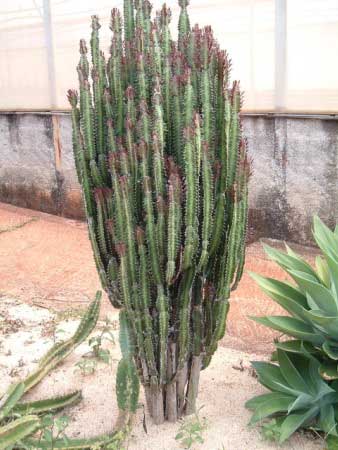
Euphorbia trigona (*)
Classification System: APG IV
Superregnum: Eukaryota
Regnum: Plantae
Cladus: Angiosperms
Cladus: Eudicots
Cladus: Core eudicots
Cladus: Rosids
Cladus: Eurosids I
Ordo: Malpighiales
Familia: Euphorbiaceae
Subfamilia: Euphorbioideae
Tribus: Euphorbieae
Subtribus: Euphorbiinae
Genus: Euphorbia
Subgenus: E. subg. Euphorbia
Sectio: E. sect. Euphorbia
Species: Euphorbia trigona
Name
Euphorbia trigona Mill. (1768)
Synonyms
Heterotypic
Euphorbia hermentiana Lem., Ill. Hort. 5(Misc.): 63. 1858.
Homonyms
Euphorbia trigona Roxb., nom. illeg. = Euphorbia lacei Craib
Distribution
Native distribution areas:
Continental: Africa
Regional: Southern Africa
Angola; Bangladesh; Congo; Gabon; India; Malawi; Zare
References: Brummitt, R.K. 2001. TDWG – World Geographical Scheme for Recording Plant Distributions, 2nd Edition
References
Primary references
Miller, P. 1768. The Gardeners Dictionary: containing the best and newest methods of cultivating and improving the kitchen, fruit, flower garden, and nursery. Ed. 8, 3 volumes (without pagination), John & Francis Rivington, London. DOI: 10.5962/bhl.title.541 Reference page. : ed. 8, n.º 3.
Links
Govaerts, R. et al. 2020. Euphorbia trigona in World Checklist of Selected Plant Families. The Board of Trustees of the Royal Botanic Gardens, Kew. Published on the internet. Accessed: 2020 Jul 13. Reference page.
International Plant Names Index. 2020. Euphorbia trigona. Published online. Accessed: Jul 13 2020.
Govaerts, R. et al. 2020. Euphorbia trigona in Kew Science Plants of the World online. The Board of Trustees of the Royal Botanic Gardens, Kew. Published on the internet. Accessed: 2020 Jul 13. Reference page.
Tropicos.org 2020. Euphorbia trigona. Missouri Botanical Garden. Published on the internet. Accessed: 2020 Jul 13.
Vernacular names
Deutsch: Dreikantige Wolfsmilch
English: African milk tree
suomi: Pylvästyräkki
Euphorbia trigona (also known as African milk tree,[1] cathedral cactus,[1] Abyssinian euphorbia,[2] and high chaparall[3][4][dubious – discuss]) is a perennial plant that originates from Central Africa.
6 External links
Description
It has an upright stem and number of branches that also grow upward. The stem and branches can have two or three sides. The stem itself is dark green with V-shaped light green patterns. The 5 mm (1⁄4 in) thorns occur in pairs on the stem's ridges. The drop shaped leaves grow from between the two thorns on each ridge. The plant has never been known to flower,[5][6] and is possibly a hybrid.[6]
Cultivation
The trigona can withstand brief cold temperatures of down to −3 °C (27 °F). It prefers sandy soil but can withstand most types of well-drained soil. It can root easily from stem cuttings, if allowed to dry for 3–7 days before planting so that it can form a callus and not rot. It grows to a height of 1.5–3 m (4 ft 11 in–9 ft 10 in).
Chemistry
As with many other Euphorbia species, the latex from the plant is poisonous and can cause skin irritations.[6] It is a pest-free plant. A problem that some trigonas face is that they are susceptible to falling over when fully grown because of their shallow and small root system [7]
Uses
The plant is only known in human cultivation and is commonly used as a house plant.[6] It is used as a ritual plant and a hedge in Gabon.[6]
References
Timothy K. Broschat, Alan W. Meerow. Betrock's Reference Guide to Florida Landscape Plants. Betrock Information Systems, 1991. p. 123. ISBN 9780962976100
Thomas C. Fuller. Poisonous Plants of California. University of California Press, 1986. p. 372. ISBN 9780520055698
http://www.ne.se/lang/trekantseuforbia (in Swedish)
http://www.krukväxter.com/HighChaparall.php (in Swedish)
James Cullen, Sabina G. Knees, H. Suzanne Cubey. The European Garden Flora Flowering Plants: A Manual for the Identification of Plants Cultivated in Europe, Both Out-of-Doors and Under Glass. Cambridge University Press, 2011. p. 498. ISBN 9780521761550
Medicinal Plants, Volume 1. PROTA, 2008. p. 260. ISBN 9789057822049
FLEURS TROPICALES DES JARDINS D'AFRIQUE, Miller, Euphorbia trigona, "Archived copy". Archived from the original on 2016-03-11. Retrieved 2016-03-10.
Retrieved from "http://en.wikipedia.org/"
All text is available under the terms of the GNU Free Documentation License

